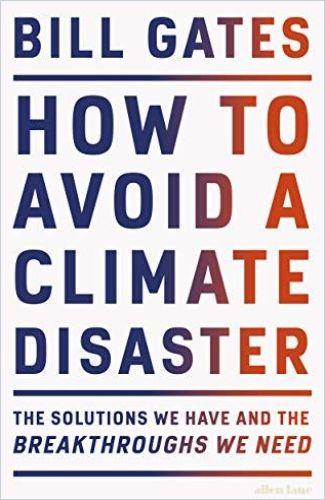Microsoft founder Bill Gates presents a clear, indispensable primer on climate change issues and possible actions.

Bill Gates Fights Climate Change
Microsoft founder Bill Gates walks the walk on climate change by minding his personal carbon footprint and investing in green technologies. In this approachable, no-nonsense text, he specifies how governments, industries and individuals can tackle daunting climate challenges that threaten life on Earth. Gates describes sweeping changes – in energy use, infrastructure, agriculture and government policies – essential to achieving zero greenhouse emissions by 2050.
Greg Williams wrote in Wired that Gates, “argues that wholesale transformation is possible.” The Wall Street Journal Magazine said, accurately, that Gates “presents ideas with the methodical approach of a college textbook. Remarkably, given the state of the world, it is an optimistic, can-do sort of book, chock-full of solutions.”
51 Billion and Zero
Gates begins by noting that people add 51 billion tons of greenhouse gases to Earth’s atmosphere annually. To avoid catastrophe, emissions must equal zero. Gates argues that people must modify travel, manufacturing, agriculture and infrastructure using technology, regulations and private investment.
The wind doesnt always blow and the sun doesnt always shine, and we dont have affordable batteries that can store city-sized amounts of energy for long enough.Bill Gates
Gates points out that the pandemic-driven short-term reduction in greenhouse gases proved that humanity cannot reach zero emissions by traveling less or working from home.
Net-Negative Emissions
Gates details how greenhouse gases – which trap heat from solar radiation – include carbon dioxide, methane and nitrous oxide. Scientists, he explains, combine them into carbon dioxide equivalents, or CO2e.
Gates cites estimates that the Earth will warm up by 3°C [5.4°F] until 2050, and by to 8°C [14.4°F] until 2100. Storms, droughts and wildfires will worsen. Sea levels will rise, affecting coastal cities and farms. Plant and animal species, Gates laments, will go extinct.
Gates’s thesis is that the world’s richest countries must commit to net-zero emissions by midcentury, and invest in scientific research.
Zero-Carbon Electricity
Gates reminds readers that fossil fuels generate two-thirds of all electric power. because they’re cheap, available and transportable. He discloses that by 2050, the world will require two to three times the electrical power now generated. Gates cites offshore wind turbines – which could provide coastal cities with reliable electricity – and geothermal energy for generating power.
Eliminate Carbon Emissions
Gates offers surprising, worrisome statistics about the deleterious effects of concrete manufacture. He tells how the United States produces 96 million tons of cement annually, and how China produced 26 billion tons from 2000 to 2016.
I think of it in three stages: We emit greenhouse gases (1) when we use fossil fuels to generate the electricity that factories need to run their operations; (2) when we use them to generate heat needed for different manufacturing processes, like melting iron ore to make steel; and (3) when we actually make these materials, like the way cement manufacturing inevitably creates carbon dioxide.Bill Gates
Each ton of concrete, the author reveals, amounts to a ton of released CO2.
70% More Food
Gates references how methane and nitrous oxide gases that agricultural sources release cause more warming than CO2. Deforestation and land clearing release an additional 1.6 billion tons of CO2. Without innovations, Gates warns that feeding the world will increase greenhouse emissions by two-thirds in a few decades.
The author strays into almost comedy club territory when he says that the world’s billion cattle produce immense amounts of methane with their farts, burps and poop.
Gates divulges that planting 50 acres of new trees in the tropics would absorb emissions equal to that produced by one American. Planting that many trees for each American, he reports, would cover half of the world’s land mass.
Transportation, Air Conditioning and Heating
Gates breaks down how transportation emits 16% of the world’s greenhouse gases – fourth behind manufacturing, electricity and agriculture. In the United States, transportation is the number-one emissions contributor.
Air conditioning and heating consume most of the energy in buildings and homes, and those demands, Gates reminds readers, will triple by 2050.
Wealthier Countries
Gates lists a litany of potential disasters: Sea level and storm surge increases mean millions of people will move from coastal cities as natural ecosystems like reefs, forests, mangroves and wetlands disappear rapidly.
Five billion people, Gates cautions, may lack access to potable water by 2050. Gates recommends as solutions desalinization and dehumidifier systems, recycling wastewater and smart crop irrigation. Gates insists investors must finance projects supporting infrastructure, agriculture, clean water and early-warning systems that help the world adapt to climate change.
Simple Declarations
Bill Gates’s speeches and public pronouncements always mirrored the tone of this book: straightforward, basic and without nuance. Gates speaks and writes like a man vested in computer code – one who distrusts language and refuses to say anything that others might misunderstand. Combined with his obvious sincerity, Gates’s pedantic tone and myriad factoids produce a primer of basics, not an in-depth exploration. In this field, such a book is welcome. Gates’s likely audience spans elementary school kids and senior citizens. Gates provides a basic, complete, fundamental text that will endure and become part of the climate change canon.
Other necessary primers on climate change issues include Elizabeth Kolbert’s Under a White Sky; Michael E. Mann’s The New Climate War; and another canonical, deliberately reductive work, No One Is Too Small to Make a Difference, by Greta Thunberg.












